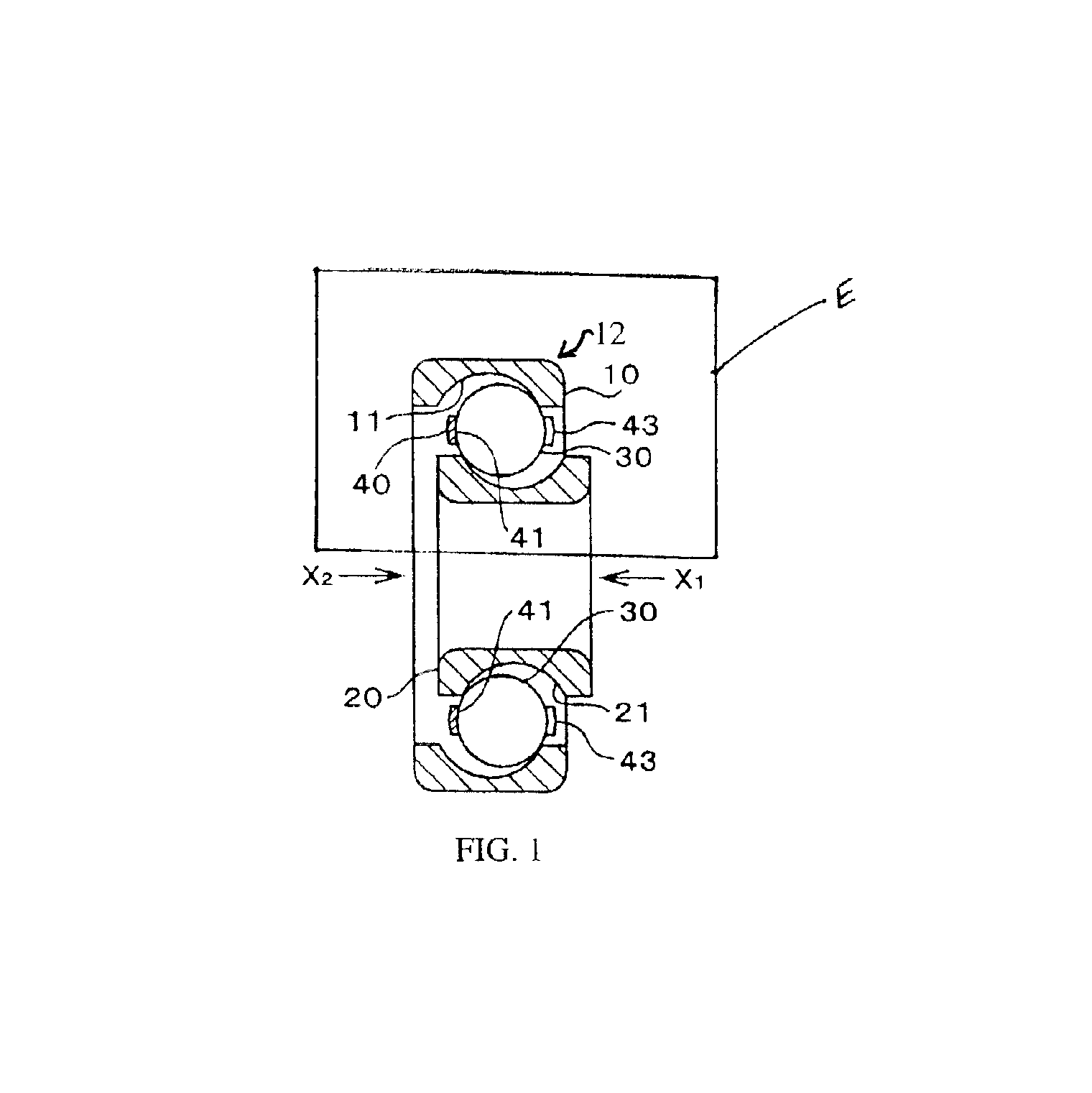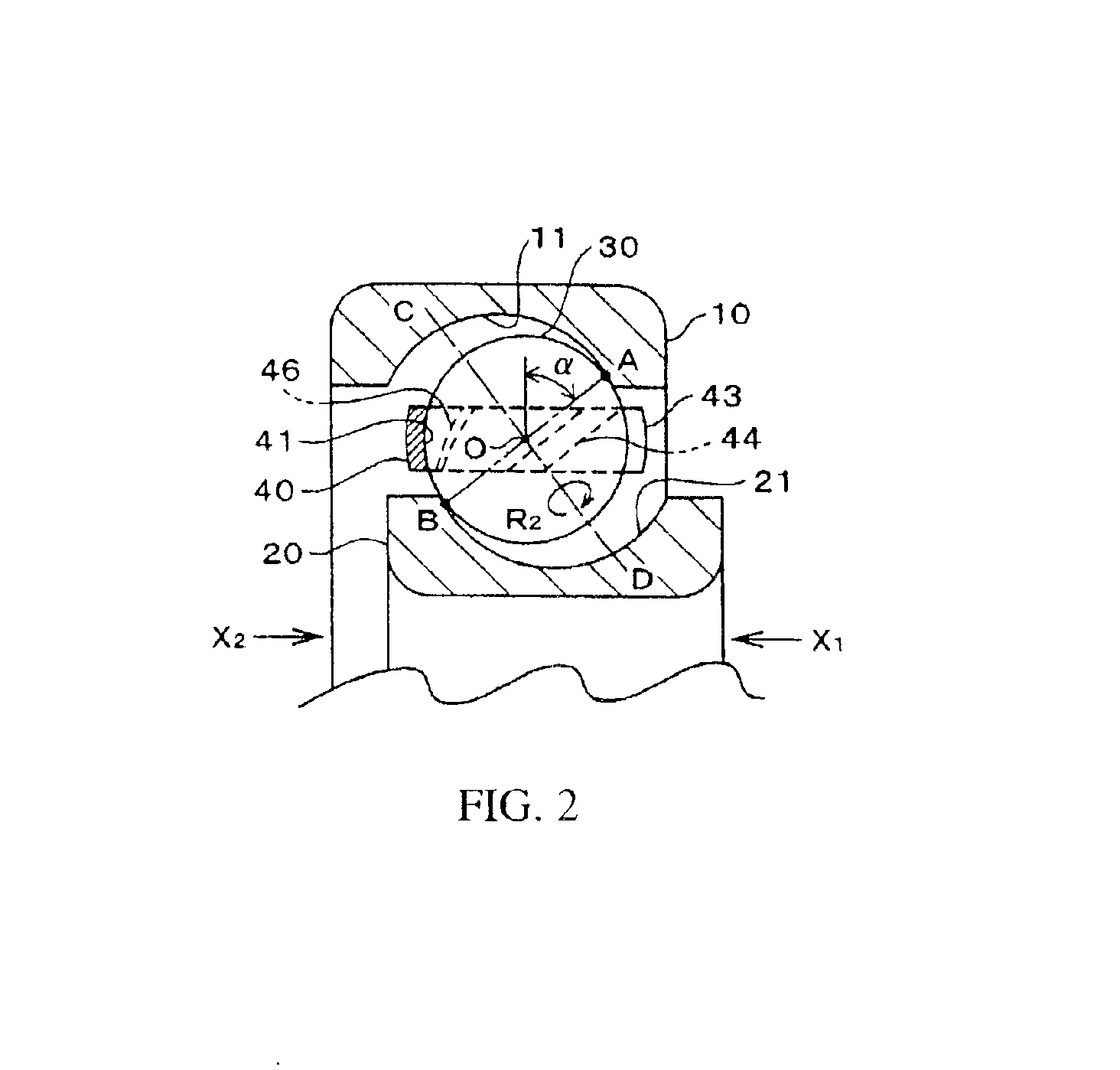Radial ball bearing retainer
a radial ball bearing and retainer technology, which is applied in the direction of rotary bearings, rolling contact bearings, shafts and bearings, etc., can solve the problems of the radial gap between the surface of the running channel and the ball bearing, and achieve the effect of reducing the rotational torque, and improving the lubrication characteristics of the radial ball bearing
- Summary
- Abstract
- Description
- Claims
- Application Information
AI Technical Summary
Benefits of technology
Problems solved by technology
Method used
Image
Examples
first embodiment
[0029]FIG. 1 depicts a deep channel type radial ball bearing 12 (hereinafter referred to as “bearing”) employing a retainer 40 of the Bearing 12 has an outer ring 10 and an inner ring 20. Running channels 11 and 21 are formed on the mutually opposing orbiting surfaces of outer ring 10 and inner ring 20, respectively. Thus, running channels 11 and 21 are on the inner perimeter surface of outer ring 10 and the outer perimeter surface of inner ring 20 respectively. A specified number of balls 30 are fit into running channels 11 and 21. Retainer 40 having pockets 41 is placed between outer ring 10 and inner ring 20. Each ball 30 is captured in pocket 41. The space between any two adjacent balls 30 is the same. Balls 30 are free to roll within their corresponding pockets 41. Running channels 11 and 21 are arc-shaped, with a diameter somewhat larger than the diameter of balls 30. The larger diameter of running channels 11 and 21 results in a radial gap between the surface of running chan...
second embodiment
[0042]FIG. 7 shows retainer 40 preferably for use when, as seen from the X1 direction, outer ring 10 rotates counterclockwise (R5 direction) and outer ring 10 and inner ring 20 are axially offset, as shown in FIGS. 1 and 2. Balls 30 rolling direction in this case is the R6 direction. Channel 46 is formed in the rolling direction of balls 30 on the inner surface of pocket 41. The lubricating oil flows in this channel 46 and is directed to the outer perimeter surface. Inclined surface 45a of fin 45 receives the lubricating oil and directs it to the vicinity of the pocket's 41 opening on the trailing side of retainer's direction of rotation.
third embodiment
[0043]FIG. 8 shows retainer 40 preferably used when the inner ring 20 rotates in a clockwise direction (R3 direction) as seen from the direction of X1 in FIGS. 1 and 2. In this case, the preload is applied to inner ring 20 in the X2 direction as shown in FIGS. 1 and 2. Balls 30 roll in the R6 direction. Channel 46 is formed in pocket's 41 inner surface in the rolling direction, and lubricating oil flows in channel 46 and is directed to the inner perimeter surface. Inclined surface 45a of fin 45 receives the lubricating oil from channel 46 and directs it to the vicinity of the opening of pocket 41 on the trailing side of the retainer's direction of rotation.
PUM
 Login to View More
Login to View More Abstract
Description
Claims
Application Information
 Login to View More
Login to View More - R&D
- Intellectual Property
- Life Sciences
- Materials
- Tech Scout
- Unparalleled Data Quality
- Higher Quality Content
- 60% Fewer Hallucinations
Browse by: Latest US Patents, China's latest patents, Technical Efficacy Thesaurus, Application Domain, Technology Topic, Popular Technical Reports.
© 2025 PatSnap. All rights reserved.Legal|Privacy policy|Modern Slavery Act Transparency Statement|Sitemap|About US| Contact US: help@patsnap.com



